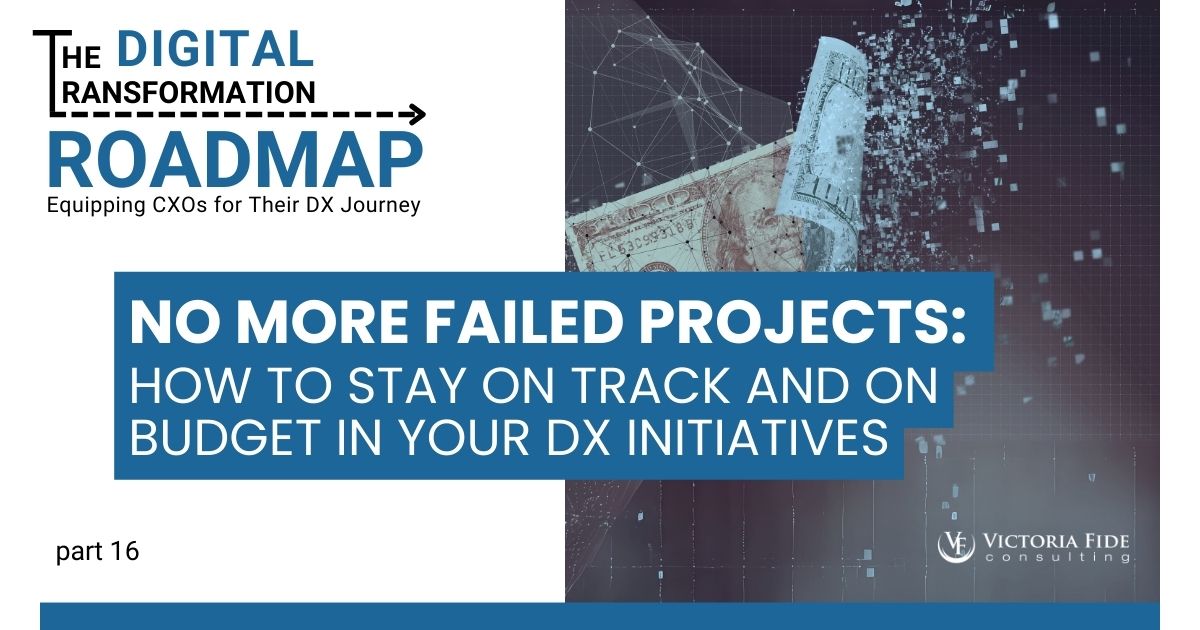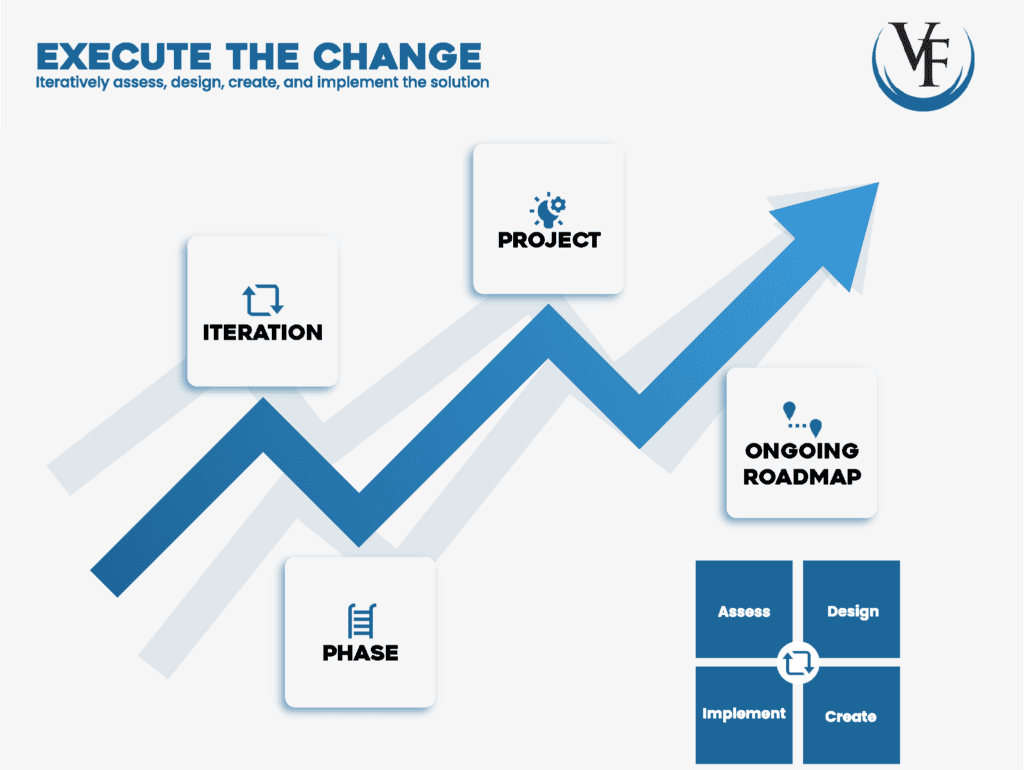
No More Failed Projects: How to Stay on Track and on Budget in Your DX Initiatives
The DX Roadmap series is produced by Victoria Fide Marketing with input and oversight from our leadership team and industry SMEs.
One of the biggest pain points in digital transformation projects is that they’re often over time and over budget. However, staying on time and on budget begins far before this step of building a project-plan timeline and budget.
To effectively plan and budget a project, you need to have completed previous preparatory steps such as performing an Enterprise Process Review, building a Project Management Plan, a Project Charter, and more. This article outlines the culmination of all the preparatory work you’ve already done to maintain a project on time and on budget.
Building out a project-plan timeline, resource plan, and budget for a project is like trying to solve three jigsaw puzzles at the same time. Each puzzle piece must fit seamlessly with the others to create a cohesive picture. Similarly, altering any single aspect of a project – be it timeline, resources, or budget – will invariably influence at least one other element.
In this article, we will explore what having an effective timeline and budget could look like for your organization, a proposed methodology to increase accuracy, and important considerations to weigh while building a project timeline, resource plan, and budget.
Table of Contents
The Ripple Effect: How Accurate Budgets and Timelines Influence Overall Business Health
No project exists in a vacuum. Every organization has multiple business and technology initiatives, competing priorities, budgets, and resource constraints. To ensure the efficacy of each initiative while maintaining day-to-day operations, companies must create and maintain a tightly aligned project-plan timeline and budget. This allows for resources including team member involvement, budget, and timeline allocation to be maximized for the greatest impact while avoiding negative impact to other areas or objectives.
Special consideration must be given to the implementation methodology when formulating a comprehensive plan for project execution. This aspect is crucial for ensuring a smooth transition and successful outcome of the project. In the following section, we will provide a detailed outline of our meticulously designed process and the recommended methodology.
This approach has been specifically developed to support digital transformation initiatives and can be customized to fit the unique needs and objectives of any project. By adopting this methodology, organizations can navigate the complexities of digital transformation more effectively, leading to enhanced efficiency and greater odds of project success.
Your Framework for Strategic Change: Proven Process for Success
Before you can develop a timeline, it’s crucial to have a clearly defined methodology. If you’ve crafted a Project Management Plan (PMP), your methodology will already be in place. Most digital transformation (DX) projects opt for a hybrid approach, blending the traditional waterfall methodology with agile practices, but each project type will follow its own set of best practices.
We have developed a proven process based on nearly 40 years of digital transformation success that is designed to combine flexibility and a proven framework for success no matter the project type. You can use this framework as a starting point for your self-directed initiative and customize as needed.
Once you’ve developed your overarching methodology, you can then map out your project timeline, spanning from the Project Kickoff to Go-Live, and further into the future. Having constructed the initial high-level draft, you can refine it to address any constraints, focal points, or other considerations, which we will explore in the next section.

Below, you’ll find a sample project plan that follows our proven methodology. We recommend an iterative approach to executing the project plan. Our Process for Transformational Change organizes project execution into four steps: Assess, Design, Create, and Implement, which can be broken further into sprints for those who are taking an agile approach. As part of our DX Roadmap series, we’ll explore these steps in greater depth at a future date and discuss how to effectively implement the project plan.
Project Kickoff
Launching a strong kickoff for the project is crucial. Be sure to involve all team members and stakeholders who have a vested interest in the outcomes. This formal start of the project establishes the plan, direction, roles, and involvement and sets expectations for everyone involved.
Once the project begins, you will need to plan for the ongoing involvement of all project resources in status meetings and other regular ceremonies throughout the cadence of your sprints. If external contractors are involved, there may be additional costs, but at the minimum you need to consider the time and resource commitment required for this ongoing involvement.
Assess
Using the information gained in the Discover and Define steps of Preparation, each project phase or iteration starts with a thorough assessment of the current state business process (a.k.a. “as-is”).
These are the critical activities in Assess that you should be planning for as you build your timeline and budget:
- Reviewing As-Is Processes
- Documenting Requirements
- Reviewing Existing Custom Development
- Enterprise Architecture Review

Transformation is not easy, but it doesn’t have to be impossible. Take control of your project’s success today and schedule a free 30-minute consultation to find out how Victoria Fide can equip you for transformational success.
Design
Once you have clearly mapped your current state process and/or your technical infrastructure you can begin to design your ideal future state (a.k.a. “to-be” or target).
These are the critical activities in Design around which you will be basing your timeline and budget:
- Define High Level Solution
- Deploying Sandbox Environment
- Iterative Design
- Approve Solution Design
- Design Data Migrations
Create
With a clear picture of your current state and your future state, you need to create an execution plan that will include clearly defined tasks, target dates, roles and responsibilities, migration plans, test plans, training plans and cutover plans.
Here are some critical activities in Create to consider as you build your timeline and budget:
- Configure System
- Develop Custom Software
- Functional Testing
- Build Data Migration
- Data Validation Testing
- Build Reports
- Build Test Scenarios, Data, and Scripts
- Business Simulation Testing
- Build Deployment Plan
- Build Training Plan
Implement
Once you have executed your plans to create the deliverables, you will also need to roll-out what you have created. The implementation step is basically rolling out your solutions that you have proven to work. Through Business Simulation Testing, you will have already proven the software will support your business processes. You now need to verify that the entire solution will support your business. Part of this step will include significant end-user testing (a.k.a. User Acceptance Testing or UAT), including data migrations and infrastructure.
These are a few critical activities in Implement:
- User Acceptance Testing
- System Integration Testing
- End User Training
- Deploy Changes
- Go Live
- HyperCare
Customizing Your Rollout Strategy: Tailored Approaches for Effective Implementation
With your methodology framework in place, it’s essential to consider these variables and modify your plan accordingly:
Timeline
Many companies experience peak periods during which they must concentrate their resources on various projects or initiatives to propel the business forward. They may also have limited timeframes during which they can implement a new technology solution.
When constructing a timeline, important considerations include the possibility of a staggered rollout, the need to manage parallel systems, dependencies that must be evaluated, and any significant travel requirements. Additionally, consider if the project should align with the start or end of a month, quarter, or year for optimal timing.
Finally, identifying the critical path is paramount. By examining all work streams to determine which requires the most effort and time, it’s essential to initiate that task immediately and diligently monitor its progress. This ensures it remains on track and does not hinder the progress of other work streams within the project.
Priorities
It’s crucial to precisely identify the essential components of the project. What constitutes the bare minimum requirements for the project to be deemed successful? This might involve mapping out a detailed, multi-phase roadmap. Bear in mind, a more focused scope significantly increases the project’s likelihood of success.
Scope
You will have already defined the scope of the project in your Project Charter. We talk about that in our article “Defining Your DX Project.” At this time, you will need to clarify it and determine how it plays into the timeline and budget.
For example, if an organization is implementing a Warehouse Management Solution, they may want to implement scanner guns to scan inventory on the floor. However, that could take significant time and budget, and it’s crucial to identify which processes will be necessary to incorporate into the current project.
Contingency
No project unfolds precisely as planned. Unforeseen challenges and external factors invariably arise, disrupting even the most well-laid plans. These can range from minor setbacks to major obstacles, greatly affecting timelines, budget, and outcomes. To mitigate these uncertainties, incorporate buffer time into the timeline, taking into account current assumptions and identified risks.
By taking these factors into account, you can skillfully customize your project-plan timeline to fit the unique needs of your project, ensuring it is as precise as possible.
The Art of Resource Planning: Balancing People, Time, and Budget
With the timeline established, you are now poised to develop a project resource plan. This involves allocating resources to specific tasks within the project timeline and estimating the required duration for each. Modern project management tools offer the functionality to directly assign resources and durations to project deliverables, encompassing both internal and external or vendor resources.
Keep in mind any resource constraints that are known at this point such as availability of key members, any competing projects, or vacation schedules. A healthy balance of available resources and the willingness to adjust as needed is key.
Properly allocating resources can help ensure accountability, avoid scheduling conflicts, and accurately assess the project’s budget needs. As with any aspect of project planning, it’s imperative to revisit this plan continually throughout the project’s life cycle, keeping in mind possible unknown factors that may arise.
Beyond the Numbers: Strategic Planning for Project Financials
Understanding the overall budget is crucial when developing the timeline and resource plan. Each project activity should serve as a foundation for the Project Budget, allowing for the allocation of costs to specific activities within the project plan. In crafting a project budget, it is important to anticipate all potential expenses, especially those that could significantly influence the project’s success.
Potential costs to consider include:
- Outside consulting services, such as a project manager, implementation partner, or digital transformation experts such as Victoria Fide.
- Software purchases and licenses. If you’ve chosen software, you already possess precise figures. If not, now is the moment to acquire detailed numbers by soliciting proposals from vendors. You can read more about that here.
- Expenses for training, which may also cover travel costs for team members attending in-person sessions, if the training is not offered remotely.
- Items designed to enhance project morale and cultivate a sense of team unity, including custom t-shirts and assorted project-themed merchandise.
- Additional resources such as custom development, data migration, or change management.
In the process of creating a budget, typically you will want to outline the following key metrics:
- Overall budget
- Vendor contracts or SOWs
- Actual Cost
- Forecast for Estimate to Complete
- Forecast for Estimate at Completion
- Estimated timeline when expenses will occur

Building on Foundations: Strategies for Accurate Budgeting and Project Management
Creating a project timeline and budget may seem straightforward, but crafting one that is both accurate and effective is a different story altogether. As previously mentioned, ensuring a project stays on schedule and within budget starts well before these steps. It requires careful consideration of five key factors: your methodology, time constraints, priorities, scope, and an adequate contingency plan. If you’ve been following our DX Roadmap series, most of these considerations should already be in place, providing a strong foundation to build upon.
Efficiency and precision in planning and execution are the hallmarks of successful project management, particularly in the realm of digital transformation. While the guidance provided in our DX Roadmap series lays out the foundational steps for project success, the unpredictable nature of project implementation suggests a need for expert insight and support. This is where Victoria Fide and our team of digital transformation experts come into play.
We understand the complexities and challenges that come with initiating and executing technology projects. With our Client Success Guarantee, we offer peace of mind and assurance that your project is not just another initiative, but a pathway to achieving your strategic objectives. Our guarantee underpins our commitment not only to meet, but exceed expectations, ensuring that your project stays on schedule and within budget.
For organizations looking to drive their digital transformation forward with confidence, now is the time to connect with Victoria Fide. Our expertise in digital strategy, project management, and implementation support will serve as a catalyst to your success.
Contact us today to discuss how we can support your next project and leverage our Client Success Guarantee for your benefit. In the meantime, make sure you’re subscribed to our newsletter for more insights and resources on achieving digital transformation success.
